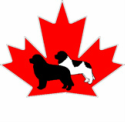Newfoundland Dog Club of Canada
Official CKC Breed Club
*** NDCC National Special Website ***
*** Online 2025 Membership Renewal Form ***
*** 2025 Breeder Code of Ethics ***
2025 Membership Renewal Form - NEW
Application for New Membership
2023 National Specialty - Conformation Results
*** Online 2025 Membership Renewal Form ***
*** 2025 Breeder Code of Ethics ***
2025 Membership Renewal Form - NEW
Application for New Membership
2023 National Specialty - Conformation Results
Newfoundland Dog
The Newfoundland is a large dog with the size and strength to perform the tasks required of him. He has a heavy coat to protect him from the long winters and the icy waters surrounding his native island. His feet are large, strong, and webbed so that he may travel easily over marshes and shores.
Essentially, the Newfoundland dog is as much at home in the water as on dry land. Canine literature give us stories of brave Newfoundlands which have rescued men and women from watery graves; stories of shipwrecks made less terrible by dogs which carried life lines to stricken vessels; of children who have fallen into deep water and have been brought safely ashore by Newfoundlands; and of dogs whose work was less spectacular but equally valuable as they helped their fishermen owners with their heavy nets and preformed other tasks necessary to their occupations. Although he is a superior water dog, the Newfoundland has been used and still is used in Newfoundland and Labrador as a true working dog, dragging carts, or more often carrying burdens as a pack horse.
In order to perform these duties the Newfoundland - must be a large dog - large enough to bring ashore a drowning man. He must have powerful hindquarters and a lung capacity which enables him to swim for great distances. He must have the heavy coat which protects him from the icy waters. In short, he must be strong, muscular, and sound so that he may do the work for which he has become justly famous. Above all things, the Newfoundland must have intelligence, the loyalty and the sweetness which are his best known traits. He must be able and willing to help his master perform his necessary tasks at command and also have the intelligence to act on his own responsibility when his rescue work demands it.
The Newfoundland dog is mainly kept, not as an active worker, but as a companion, guard and friend. We appreciate particularly the sterling traits of the true Newfoundland disposition. Here we have the great size and strength which makes him an effective guard and watchdog combined with the gentleness which makes him a safe companion. For generations he has been the traditional children's protector and playmate. We know of no better description of the character of the Newfoundland dog than the famous epitaph which reads:
Essentially, the Newfoundland dog is as much at home in the water as on dry land. Canine literature give us stories of brave Newfoundlands which have rescued men and women from watery graves; stories of shipwrecks made less terrible by dogs which carried life lines to stricken vessels; of children who have fallen into deep water and have been brought safely ashore by Newfoundlands; and of dogs whose work was less spectacular but equally valuable as they helped their fishermen owners with their heavy nets and preformed other tasks necessary to their occupations. Although he is a superior water dog, the Newfoundland has been used and still is used in Newfoundland and Labrador as a true working dog, dragging carts, or more often carrying burdens as a pack horse.
In order to perform these duties the Newfoundland - must be a large dog - large enough to bring ashore a drowning man. He must have powerful hindquarters and a lung capacity which enables him to swim for great distances. He must have the heavy coat which protects him from the icy waters. In short, he must be strong, muscular, and sound so that he may do the work for which he has become justly famous. Above all things, the Newfoundland must have intelligence, the loyalty and the sweetness which are his best known traits. He must be able and willing to help his master perform his necessary tasks at command and also have the intelligence to act on his own responsibility when his rescue work demands it.
The Newfoundland dog is mainly kept, not as an active worker, but as a companion, guard and friend. We appreciate particularly the sterling traits of the true Newfoundland disposition. Here we have the great size and strength which makes him an effective guard and watchdog combined with the gentleness which makes him a safe companion. For generations he has been the traditional children's protector and playmate. We know of no better description of the character of the Newfoundland dog than the famous epitaph which reads:
Near this spot
are deposited the remains of one
who possessed Beauty without Vanity
Strength without Insolence
courage without Ferocity
and all the Virtues of Man without his Vices.
This praise, which would be unmeaning Flattery
if inscribed over human Ashes,
is but a just tribute to the Memory of
Boatswain, a Dog
who was born in Newfoundland May 1803
and died at Newstead Nov. 18th, 1808
~ Lord Byron

